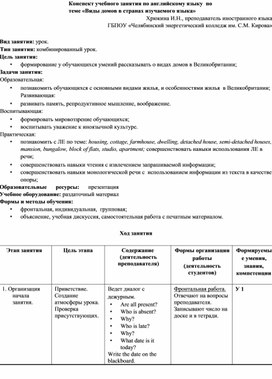Конспект учебного занятия по теме "Виды домов в странах изучаемого языка" (английский язык)

Конспект учебного занятия по английскому языку по теме «Виды домов в странах изучаемого языка»
Хрюкина И.Н., преподаватель иностранного языка
ГБПОУ «Челябинский энергетический колледж им. С.М. Кирова»
Вид занятия: урок.
Тип занятия: комбинированный урок.
Цель занятия:
• формирование у обучающихся умений рассказывать о видах домов в Великобритании;
Задачи занятия:
Образовательная:
• познакомить обучающихся с основными видами жилья, и особенностями жилья в Великобритании; Развивающая:
• развивать память, репродуктивное мышление, воображение.
Воспитывающая:
• формировать мировоззрение обучающихся;
• воспитывать уважение к иноязычной культуре.
Практическая:
• познакомить с ЛЕ по теме: housing, cottage, farmhouse, dwelling, detached house, semi-detached houses, mansion, bungalow, block of flats, studio, apartment; совершенствовать навыки использования ЛЕ в речи;
• совершенствовать навыки чтения с извлечением запрашиваемой информации;
• совершенствовать навыки монологической речи с использованием информации из текста в качестве опоры;
Образовательные ресурсы: презентация Учебное оборудование: раздаточный материал Формы и методы обучения:
• фронтальная, индивидуальная, групповая;
• объяснение, учебная дискуссия, самостоятельная работа с печатным материалом.
Ход занятия
|
Этап занятия |
Цель этапа |
Содержание (деятельность преподавателя) |
Формы организации работы (деятельность студентов) |
Формируемы е умения, знания, компетенции
|
|
1. Организация начала занятия. |
Приветствие. Создание атмосферы урока. Проверка присутствующих. |
Ведет диалог с дежурным. • Are all present? • Who is absent? • Why? • Who is late? • Why? • What date is it today? Write the date on the blackboard. |
Фронтальная работа. Отвечают на вопросы преподавателя. Записывают число на доске и в тетради. |
У 1
|
|
2. Ознакомление с темой урока, постановка его целей и задач |
Сформулировать тему урока. Сообщить цели и задачи. |
Организует работу с пословицей. Men make houses, women make homes. • Read. • How do you understand? • What shall we speak about today? |
Фронтальная работа. • Читают пословицу • Выражают свои мысли по поводу значения пословицы • Формулируют тему занятия. |
У 1 |
|
3. Проверка домашнего задания. |
Проверить знание ЛЕ по теме. Совершенствовать умение |
Задает вопросы по картинке. What are the parts of a house? |
Фронтальная работа. Называют части дома по картинке |
З 1 |
|
|
использовать ЛЕ в речи. |
• Guess what conveniences there are in the house. • What rooms are there in the picture?
• Describes the rooms. • Describe your own house or flat. |
• Называют возможные удобства в доме. • Называют комнаты по картинке и описывают их. • Описывают свой дом по опоре.
1. House/flat 2. Large/small 3. Conveniences 4. Rooms 5. My favourity room: o name o description o furniture o walls o floor o ceiling |
|
|
4. Основной этап занятия. 4.1 Изложение нового материала. |
Познакомить с ЛЕ по теме. |
• Организует семантизацию ЛЕ (с помощью словаря) housing, cottage, farmhouse, dwelling, detached house, semidetached houses, mansion, bungalow, block of flats, studio, apartment • Организует проверку (чтение слов с переводом) • Организует контроль. o Назвать слова по картинке o Сказать где ты живешь, где живут твои родственники. |
Индивидуальная работа: Находят значения слов в словаре. housing - жилье cottage - коттедж farmhouse – сельский дом dwelling – жилье detached house – отдельный дом semi-detached houses – дом на двух хозяев. mansion – большой дом bungalow – дом с верандой block of flats – многоквартирный дом studio - студия apartment – квартира Фронтальная работа. • Читают слова с переводом. • Называют слова по картинкам. |
ОК 2
|
|
4.2. Первичное закрепление изученного материала |
Совершенствовать навыки устной речи: учить составлять аргументированно |
Организует работу с текстом: o Чтение o Таблица |
Групповая работа. По группам выбирают преимущества и недостатки дома. |
ОК 4 ОК 6 У 3 |
|
|
е высказывание в рамках темы. |
We can hardly say that today there exist the problem of choosing a type of housing. Everyone can find something he or she likes. For instance, some people prefer to live somewhere in the country in a small, but cosy cottage or a large farmhouse. To my mind those people, who prefer this type of dwelling really adore nature. One of advantages living in such a house is that you have your own land where you can grow fruit and vegetables. But the greatest disadvantage of living in a farmhouse or in a cottage, in my opinion, is that it takes much time to get the nearest town, but if you have a car it isn’t a problem for you. That’s why I think over the possibility to live in a cottage when I retire. There are also those who like semi-detached houses. I believe that such houses attract people because they are less expensive than mansions or bungalows for example and you have only one neighbour as opposed to block of flats. Below I’ve mentioned such a type of housing as a block of flats. I consider that it’s the cheapest type of dwelling in a town. Flats can be of different sizes: one-roomed, two-roomed, three-roomed, so one can choose a flat he/she likes. If you are going to live alone, you can prefer a studio to a large apartment. Besides among advantages of living in a block of flats some people name the fact that it takes less time to tidy up a flat than a house. But as any type of housing a flat has its disadvantages: your neighbours can make a lot of noise. And the last type of dwelling I want to mention is a detached house. It has a lot of advantages: first of all your neighbours can never disturb you. But at the same time if you want to ask your neighbours for something or just to have a talk you can visit them. In the end I’d like to add that there are many types of housing and all the people have the right to choose. |
|
||
|
|
|
Контроль: высказывание от группы или ролевая игра «Какой дом выбрать?» |
Работают 4 группы: ü Cottage or farmhouse ü Semi-detached house ü Detached house ü Block of flats |
|
|
|
Совершенствовать навыки устной речи: построение устного высказывания по опоре. |
Организует работу с текстом: o Чтение o Ответы на вопросы o Построить высказывание: I knew … I learnt … I find interesting … |
Индивидуальная работа • Читают текст • Отвечают на вопросы • Строят устное высказывани е
|
ОК 2 ОК 3 ОК 4 У 3 |
||
|
The Typical British House. There are many different kinds of homes in Britain. Many British people love old houses and these are often more expensive than modern ones. They also love gardening and you will see gardens |
|||||
|
|
|
|
everywhere you go. Some gardens are small with just one tree and a few flowers. Others are large with plenty of flowers and fruit trees. Their lawns ([lo:n] - газон) are carefully cropped (высажены), their flowerbeds (клумба) are cultivated ([`k٨ltiveitid] - ухожены) because British people are careful about almost ([olmoust] - почти) everything. They call a big garden in front of their house – “front yard”(передний дворик). In the backyard (задний дворик) sometimes there is a swimming pool. Two third of the families in Britain own their houses. A typical British house has got two floors: the ground floor and the first floor (British people say “the ground floor” but the Russian people say “the first floor”). There is a living room, a dining room and a kitchen on the ground floor. And there are bedrooms and a bathroom on the first floor. A typical British family has got three or four people: mother, father and two children. But old people, young family and unmarried people do not usually live together. 1. What kinds of homes do British people love best of all? 2. Do British people like gardening? Why? 3. How many floors are there in the typical British house? 4. What rooms are there on the first floor? 5. What rooms are there on the ground floor? 6. How many people are there in the typical British family? 7. Do old people and young family live together in Britain? |
|
|
|
Организует работу по развитию навыков устной речи |
Строят устное высказывание по опоре. Old houses (cottages) Front yard – back yard Floors Rooms on the ground floor Rooms on the first floor People |
||||
|
5. |
Подведение итогов урока и постановка домашнего задания |
Провести рефлексию Выставить оценки за урок. Дать домашнее задание |
Организует рефлексию. Дает домашнее задание. Комментирует домашнее задание. Отвечает на возможные вопросы. Выставляет отметки, дает им комментарий. |
Записывают домашнее задание. |
|
.
© ООО «Знанио»
С вами с 2009 года.
![]()



